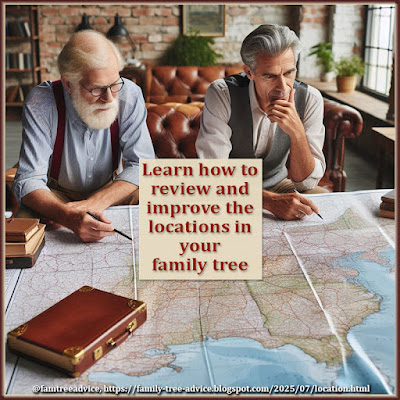An article in "Who Do You Think You Are" magazine looks at the research guidance feature in Legacy 10 software. (This software is 100% free at legacyfamilytree.com.) This feature is like having a professional genealogist sitting beside you saying, "Have you looked here yet?"
From what I can see, this feature is like the benevolent AI of the 1980s. People are wary of AI now because it's eliminating jobs for humans and creating false imagery. But Artificial Intelligence has been around for a long time.
 |
| Your self-built genealogy intelligence can rival any artificial intelligence for working on your family tree. |
In 1986 I was a copywriter for a computer software company. I wrote a brochure and article about their new AI software called MINDOVER. It used AI to track mainframe computer systems and predict problems before they happened. I was so intrigued that I tried to write an AI program about a favorite subject of mine: architecture. The first step was to build its knowledge base. I entered the names of architectural styles and the features each one included. The software then asked a question like, "Does the building have this feature?" Based on your answer, it narrowed down the style asked the next logical question.
You're already using your own intelligence to build your family tree. That intelligence comes from your experience. And it grows in value each time you work on your tree. That intelligence might look something like this. Let's say a family member tells you they think your relative married in New York City in about 1920. What can you do to prove this? You might:
- Search for the couple in the U.S. Federal Census in 1920, 1930, 1940, and 1950 to narrow down the year they married.
- Search for the couple in the New York State Census of 1925 for any more clues.
- Search the "New York, New York, U.S., Marriage License Indexes, 1907-2018" database for the date of their marriage license.
- Search the New York City Municipal Archives for the marriage certificate. (See Day 5 in "7 Days to a Better Family Tree".)
- Search their local newspapers for a marriage or engagement announcement.
If this process makes perfect sense to you, then your own genealogy intelligence is doing a fine job. But if this whole concept is brand new to you, the AI research guidance feature may be the kick-start you need.
If you don't want to switch to Legacy 10 software, you have 3 options:
- Install Legacy 10 and import your GEDCOM file. Follow its research suggestions, but record the data in your family tree software. Or,
- Use Family Tree Analyzer to show you which types of documents you're missing. Or,
- Learn which resources are available and search every one that applies. For example:
- Which censuses are available for the country where a particular relative lived?
- Which vital records (birth, marriage, death) are available for their location?
- If the person emigrated, can you access their ship manifest to learn more?
- Can you find their naturalization records?
- Which military records are available even if the person never served in the armed forces?
- Are there city directories for the place where they lived?
- Is their school yearbook online?
- Was this person ever mentioned in their local newspaper? You may find a birth or marriage announcement, an obituary, or a human interest story.
- If they traveled, can you find their passport application?
Once you've run through every possible type of record, you have built your internal knowledge base. You can refresh your memory on the types of documents available by doing what I did to write the list above. Consult your file folders.
The FamilyTree folder on my computer has sub-folders for different types of documents. These include:
- applications
- census
- certificates (that's vital records)
- city directories
- draft cards
- immigration
- military records
- naturalization
- newspapers
- passports
- yearbooks
- and a few others.
If you're new to this hobby, go to your favorite genealogy website and search for a person. Take note of the results page and the types of documents it offers to you. Ancestry has a feature on their search results page called "Browse by collection". This makes it easy to see the types of documents in the results.
I did a search for my great grandfather who came to America several times but always went home to Italy. The collections in his results included:
- Census & Voter Lists
- Birth, Marriage & Death
- Military
- Immigration & Emigration
- Directories & Member Lists
- Court, Land, Wills & Financial
- Family Trees
These results were not all for my great grandfather—some were for men with roughly the same name. But this is a good way to get familiar with the main types of records available. Then it's a matter of looking at what you have for a person, and using logic to decide what else you may find.
I've written several times about my Document Tracker spreadsheet. The overwhelming size of my family tree made me abandon this tool. But if you're new to family tree building, this spreadsheet is a great substitute for AI. It's pre-built intelligence that will help you gain the experience you need.
Are you using the research guidance feature in Legacy 10? If so, please share your experience in the comments of this article.













